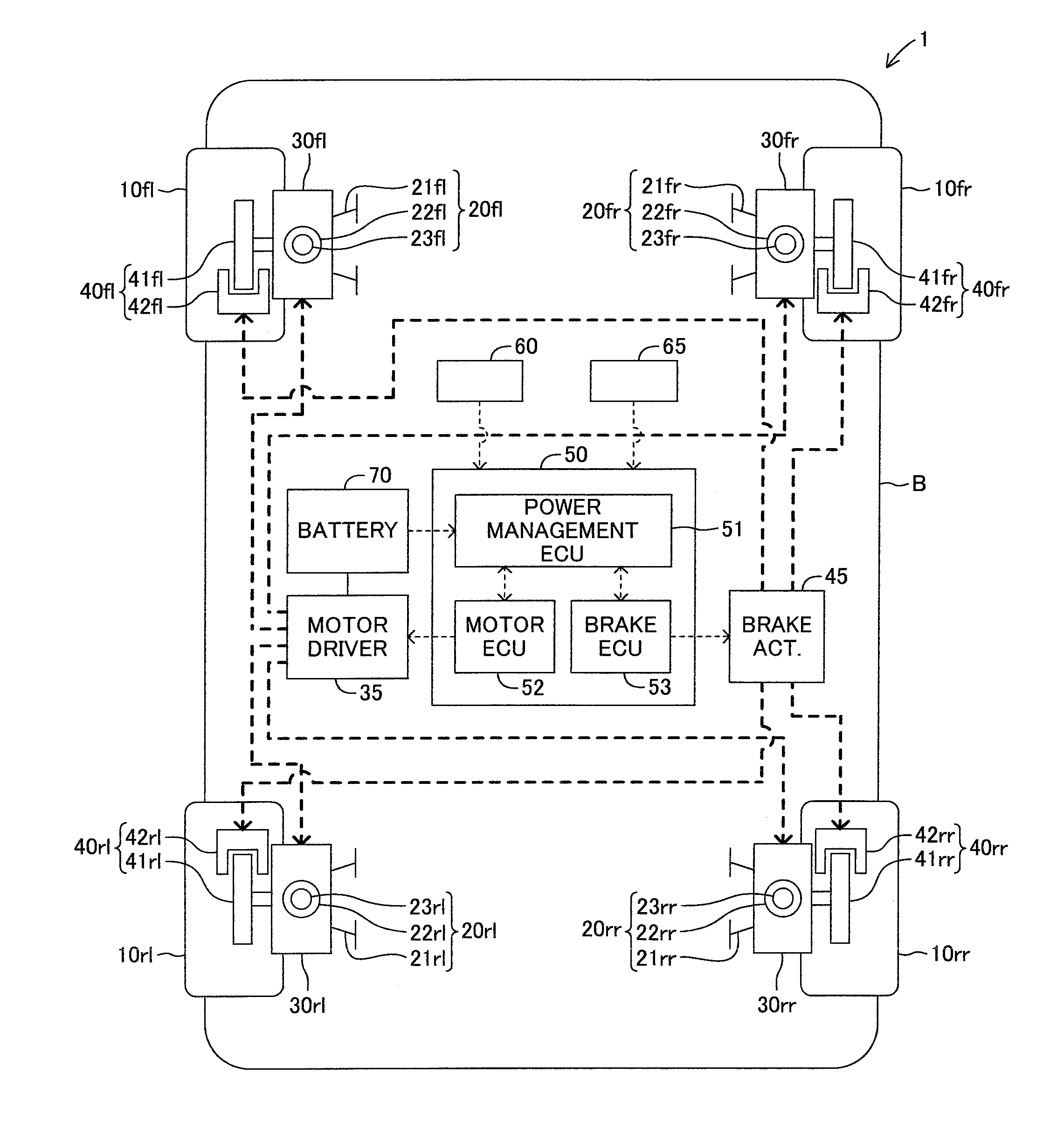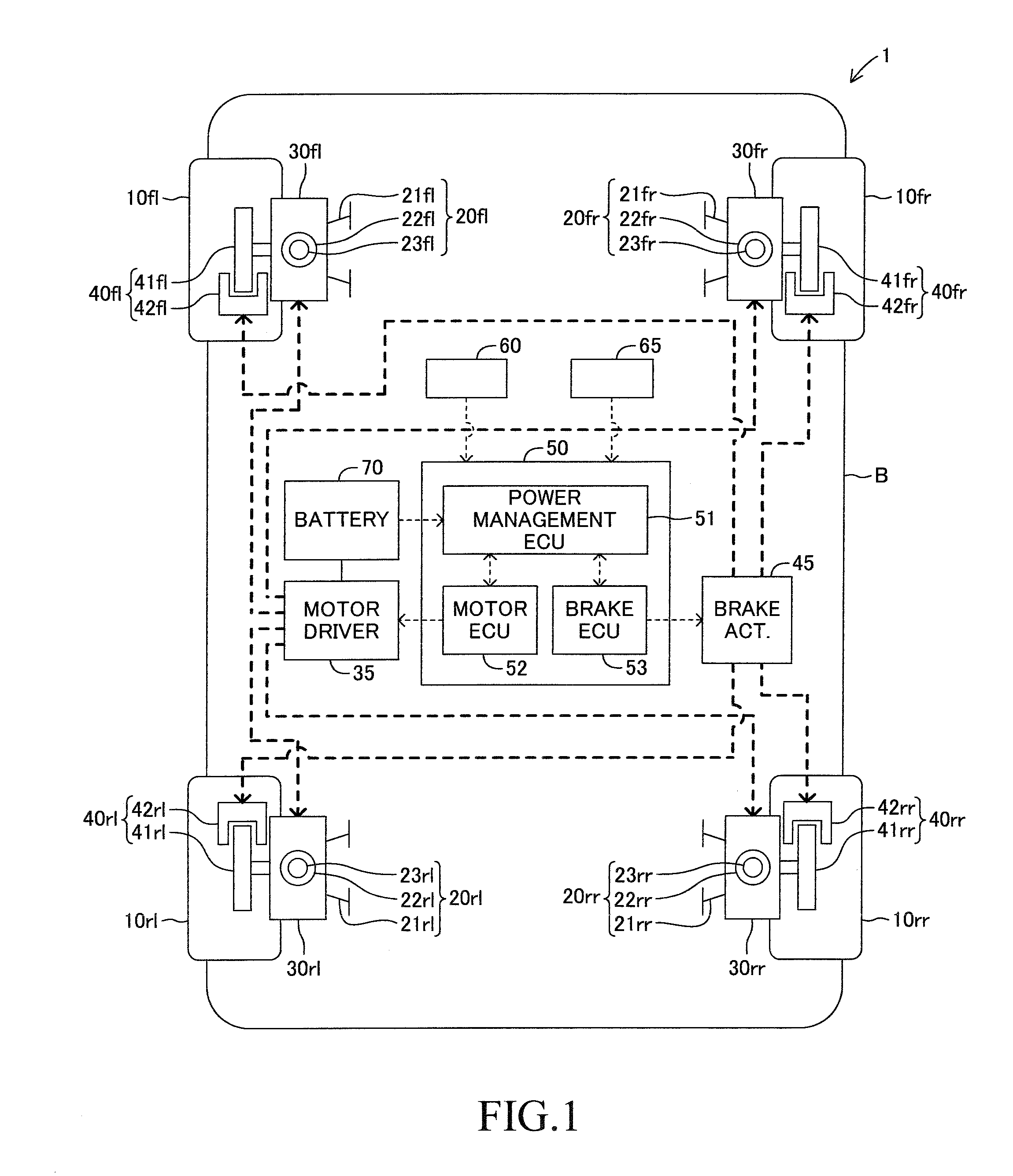Braking force control apparatus for a vehicle
- Summary
- Abstract
- Description
- Claims
- Application Information
AI Technical Summary
Benefits of technology
Problems solved by technology
Method used
Image
Examples
modified example 1
[0154]In the embodiment described above, the state flag fst is set based on the motion state or the operation state of the vehicle, but, in Modified Example 1, the state flag fst is set by further considering the usage rate of the motor torque. FIG. 10 and FIG. 11 are flowcharts for illustrating processing as Modified Example 1. FIG. 10 is a flowchart for illustrating a motor torque usage rate setting routine. FIG. 11 is a flowchart for illustrating a final state flag setting routine additionally reflecting a motor torque usage rate flag.
[0155]The brake ECU 53 starts the motor torque usage rate flag setting routine, and, in Step S121, calculates a motor torque usage rate A. In this case, the brake ECU 53 acquires, from the power ECU 51, data representing the target braking / driving torques of the four wheels and the braking torques that can be generated by the motors 30 currently calculated, and calculates the motor torque usage rate A based on the data. The target braking / driving to...
modified example 2
[0165]Under a state in which a grip force of the tire is approaching a limit during the braking, even when the driver-requested braking force is generated by the friction braking force to provide a margin for the vehicle motion control to the motor 30, satisfactory vehicle motion control cannot be carried out in the first place. Thus, in Modified Example 2, when this state is detected, by shifting the braking force that generates the driver-requested braking force from the friction braking force to the regenerative braking force, a kinetic energy, which was supposed to be lost by the friction braking, is converted into an electric energy, and is recovered to the battery 70.
[0166]FIG. 12 and FIG. 13 are flowcharts for illustrating processing as Modified Example 2. FIG. 12 is a flowchart for illustrating a slip rate flag setting routine. FIG. 13 is a flowchart for illustrating a final state flag setting routine additionally reflecting a slip rate flag.
[0167]The brake ECU 53 starts the...
modified example 3
[0179]Modified Example 2 may be combined with Modified Example 1. In this case, the brake ECU 53 executes the vehicle motion state determination flag setting routine illustrated in FIG. 9, the motor torque usage rate flag setting routine illustrated in FIG. 10, and the slip rate flag setting routine illustrated in FIG. 12 to calculate the vehicle motion state flag fstP, the motor usage state flag fstA, and the slip rate flag fstS. Then, the brake ECU 53 uses those three types of flags to execute a state flag setting routine illustrated in FIG. 15.
[0180]When the state flag setting routine (FIG. 15) starts, in Step S161, the brake ECU 53 determines whether or not the slip rate flag fstS is set to OFF. When the slip rate flag fstS is set to OFF (Yes in Step S161), in Step S162, the brake ECU 53 sets the state flag fst to OFF. On the other hand, when the slip rate flag fstS is set to ON (No in Step S161), in Step S163, the brake ECU 53 determines whether or not the vehicle motion state ...
PUM
 Login to View More
Login to View More Abstract
Description
Claims
Application Information
 Login to View More
Login to View More - R&D Engineer
- R&D Manager
- IP Professional
- Industry Leading Data Capabilities
- Powerful AI technology
- Patent DNA Extraction
Browse by: Latest US Patents, China's latest patents, Technical Efficacy Thesaurus, Application Domain, Technology Topic, Popular Technical Reports.
© 2024 PatSnap. All rights reserved.Legal|Privacy policy|Modern Slavery Act Transparency Statement|Sitemap|About US| Contact US: help@patsnap.com










